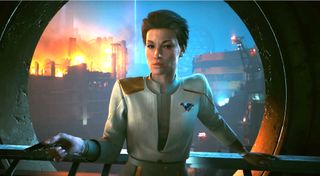CDPR dev admits that Cyberpunk 2077 ‘could have been better’
>
In a recent stream, Cyberpunk 2077’s quest director Paweł Sasko took time to answer viewer questions about the highs and lows of CD Projekt Red’s dystopian sci-fi RPG.
In what would otherwise have been a run-of-the-mill stream of Cyberpunk 2077, Sasko used the platform to answer some fan questions about the title’s storyline and had plenty to say about the narrative design (via PCGamesN (opens in new tab)).
He acknowledged that the game has an “insane amount of linearity” and that the different branches of player choice were “unsatisfactory”. He further highlighted how developers tend to “see non-linearities in a much broader sense than players”, which meant that “for the players [Cyberpunk 2077’s story choices] were not enough”.
That said, Sasko described some of the player criticism as “slightly exaggerated”. “People claim there is nothing, [but]if you use such a strict definition [of what branching storylines are]then you come to the fact that literally only the biggest industries matter and nothing else,” Sasko said. “I’m not saying we did a great job. I’m fine with it. I think it could have been better.”
You can find the full stream at Sasko’s Twitch channel (opens in new tab). His discussion of player questions and the narrative design of Cyberpunk 2077 can be found at 1:17:00 if you want to hear his comments for yourself.
Story time
Sasko also drew comparisons between Cyberpunk 2077 and CD Projekt Red’s previous project: The Witcher 3. The Witcher 3 set the bar high for story-driven open-world RPGs with branching narratives, and Sasko spoke highly of it: “it’s not possible to have identical playthroughs [of The Witcher 3] not at all”.
“Players expected more [from Cyberpunk], because of the way The Witcher 3 is built… expectations were higher,” explains Sasko. “In The Witcher 3 you had giant branches [including] the Bloody Baron… vampires or [the] fairy world [in Blood and Wine].” This meant that when it came to Cyberpunk 2077, “expectations were [high] as for big [narrative] branches”, meaning that the “incredibly linear” Cyberpunk would never meet player demand.
Sakso then discussed a particular branching story path in Cyberpunk 2077 as a point of comparison, namely the (potential) death of Arasaka Corporation agent Goro Takemura. “Takemura may die or not… [it took] so much to do [both branches] work” from a narrative design perspective. However, Sakso admitted that once people learn that you can save this fan-favorite character by completing a hidden secondary objective in a main story quest, they “run to save him,” meaning “something designed not to to be linear”. [stops being] a choice.”
In a recent playthrough of Cyberpunk 2077 over the Christmas break, I discovered this previously unknown story path for myself. Once I learned that Takemura could be rescued from his predicament, I loaded up a previous save and got the desired result. CD Projekt Red had presented Takemura as a likeable character so well that letting him die no longer seemed like a palatable option. Sakso was right: it wasn’t really a choice.
The revelations Sakso offered in his Twitch stream remind us that it’s not enough to fill a game with random player picks; the choices must mean something – each offers a unique and valuable story in its own right.

